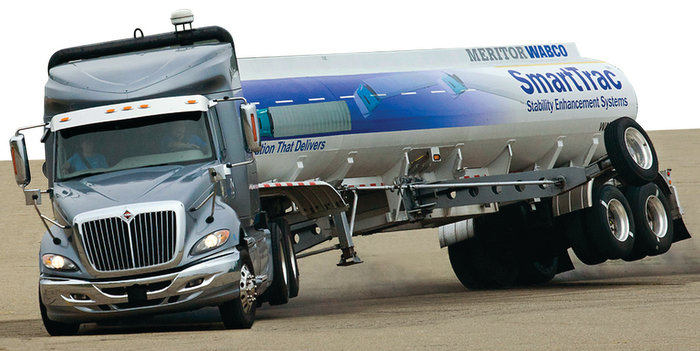The National Highway Traffic Safety Administration (NHTSA) will require full-stability technology on most new Class 7 and Class 8 tractors—“typical” 6×4 tractors—starting in August of 2017. As with all commercial safety technologies, full-stability systems are subject to the laws of physics, and ultimate responsibility for control of a vehicle remains with the driver. No system replaces a safe, alert driver practicing safe driving habits, supported by proactive, ongoing driver training programs.
“Just as anti-lock braking systems [ABS] improve vehicle stability during braking, automatic traction control [ATC] improves vehicle stability and traction during vehicle acceleration,” says Tom Weed, engineering supervisor for Bendix Commercial Vehicle Systems. “The Bendix ESP EC-80 Controller’s ATC function uses the same wheel speed information and modulator control as the ABS function. It detects excessive drive wheel speed, compares the speed to the front, non-driven wheels, and reacts to help bring the wheel spin under control. The Controller can be configured to use engine torque limiting and/or differential braking to control wheel spin. Both methods are recommended for optimal ATC performance.”
Automatic control
Bendix offers the Bendix eTrac automated air pressure transfer system for Bendix ABS-6 braking systems with automatic traction control. “The system helps drivers of 6×2 vehicles automatically overcome low-traction events by fully automating the traditional manual air pressure transfer process.” Weed explains. “Unlike a manual system, eTrac can respond in fractions of a second to a low-traction situation, offering real-time adjustment. When added to Bendix Smart ATC, eTrac automatically engages and disengages—without driver input—the vehicle’s air bag pressure transfer system during low-traction events.”
The Bendix eTrac system transfers pressure from the undriven axle to the driven axle without requiring manual input or driver action. When the system engages, it automatically evacuates air bag pressure, dropping the nose of the trailer. The resulting extra forward weight on a 6×2 tractor helps compensate for the lack of a second drive axle to deliver traction control that is comparable to a 6×4 tractor in many situations.
Weed notes that the Bendix ESP EC-80 has an additional feature known as the Bendix SMART ATC system. This system monitors the accelerator pedal position using J1939 data to help provide optimum traction and vehicle stability.
“By determining the driver’s throttle input and adapting the target slip of the drive wheels to the driving situation, the Bendix SMART ATC system allows higher wheel slip when the accelerator pedal is applied above a preset level,” he says. “Additionally, the wheel slip allowed by SMART ATC is decreased when driving through a curve, for improved stability.
Drag Torque Control is also provided with ATC. This feature reduces wheel slop on a driven axle due to driveline inertia. The condition is addressed by increasing the engine torque to overcome the inertia. Drag torque control increases vehicle stability on low-traction road surfaces during down-shifting or retarder braking. In some road conditions, the vehicle operator may desire additional drive wheel slip when ATC is active. The Bendix ESP EC-80 has an optional control mode—ATC Mud/Snow [off-road] mode—to permit this desired performance.

How it works
Michael Lambie, marketing department manager for Meritor WABCO Vehicle Control Systems, explains that traction control, or electronic traction control, utilizes the anti-lock braking system to detect and control wheel spin and stabilize traction. “ATC has been around for more than 20 years and it provides two main benefits: It reduces the potential of jackknifing and loss of stability caused by excessive wheel spin during acceleration on low-friction surfaces and improves traction at lower speeds due to loss of traction on one driven wheel, e.g. under split driving conditions,” he says. “In addition, wheel speed sensors are used to determine drive axle slip by comparing the speed of the drive axle wheels to the speed of the wheels on the steering axle. When the speed of the drive axle exceeds that of the steering wheels by a predetermined amount, the traction control software in the ABS electronic control unit [ECU] can command either of two different events: A reduction of engine torque/speed [RPM], or application of the drive axle brake on one side of the drive axle. Engine torque reduction is controlled via electronic CAN interface. Brake application is achieved via a special ATC solenoid valve providing pressure to the driven wheels, which is then individually modulated appropriately by the ABS solenoid valves. This leads to a transfer of drive torque to the driven wheel, which is not slipping, thus improving vehicle traction.”
Lambie explains that the electronic control unit is a minicomputer that can be used to control much more than brakes and being connected to the vehicle’s communication bus enables communication and control of others systems.














